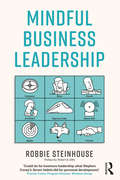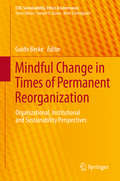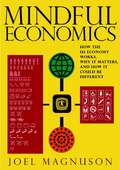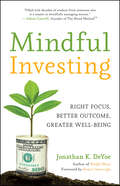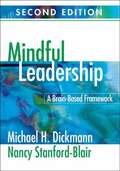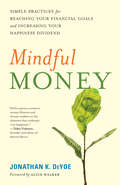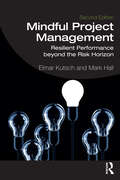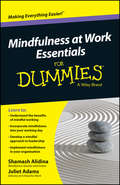- Table View
- List View
MindPowered® Coaching for Professionals: Unlocking Innovation through Cognitive Mastery (Routledge-Solaris Applied Research in Business Management and Board Governance)
by Alvin OhIn an era where digital transformation reshapes every industry, the greatest competitive advantage isn't technology—it's the power of the human mind. MindPowered® Coaching (MPC) revolutionizes how leaders and organizations approach innovation, revealing the profound connection between mindset and breakthrough thinking.Drawing from extensive research and real-world applications, this book unveils 22 core principles that form the foundation of the MindPowered® Coaching framework. Through detailed case studies of successful implementations across global organizations, readers will discover how to cultivate environments where innovation thrives naturally. This book delves deep into the psychology of creative problem-solving, exploring how mindset shifts can trigger organizational transformation. It presents practical strategies for developing cognitive resilience, enhancing collaborative thinking, and building sustainable innovation practices. Each chapter combines theoretical insights with actionable techniques, providing a comprehensive roadmap for implementing MPC within any organizational context.Perfect for CEOs, business leaders, and professionals navigating the digital age, this book provides the tools to transform how your organization approaches innovation. Whether you're leading a digital transformation or seeking to amplify your team's creative potential, MindPowered® Coaching offers the blueprint for turning cognitive capabilities into competitive advantages.
MindTree: A Community of Communities
by David A. Garvin Rachna TahilyaniMindTree is a mid-sized Indian IT services company known for its knowledge management practices, its collaborative communities, and its strong culture and values. The CEO has set a goal of becoming a $1 billion company by 2014; to reach that goal, employees must create several new businesses. The head of knowledge management must decide how his function should change in order to become more supportive of innovation and new business development.
MindTree: A Community of Communities
by David A. Garvin Rachna TahilyaniMindTree is a mid-sized Indian IT services company known for its knowledge management practices, its collaborative communities, and its strong culture and values. The CEO has set a goal of becoming a $1 billion company by 2014; to reach that goal, employees must create several new businesses. The head of knowledge management must decide how his function should change in order to become more supportive of innovation and new business development.
Mindful Business Leadership
by Robbie SteinhouseMindful Business Leadership presents a new model of leadership. It introduces ten very different leadership roles that are required to meet the challenges of modern business. Memorable metaphors and images are created for each, and they are placed in a matrix. Readers are shown how to develop these roles within themselves. Potentially negative aspects of each are discussed, along with material on how to put these to creative use. The book argues that mindfulness is the best way to balance the roles – a mindful leader will know ‘who to be’ in any situation. The last part is taken up with clear, practical exercises that readers can practice to become more fully mindful and develop a clear vision for their own leadership. Mindful Business Leadership is relevant to anyone, anywhere in the world, who is moving (or wishes to move) to a position of leadership.
Mindful Change in Times of Permanent Reorganization
by Guido BeckeSince the 1990ies, organizations from different sectors have been operating in increasingly dynamic socio-economic environments characterized by unexpected events and instability. Organizations tend to adjust to dynamic environments by change initiatives promoting permanent reorganization. Such change initiatives often induce unintended effects, e. g. an erosion of trust, the violation of 'psychological contracts' in employees' eyes or a decrease in organizational effectiveness. This book explores and analyzes whether such unintended effects can be anticipated or constructively dealt with by mindful change. The latter refers to the concept of organizational mindfulness that originally is linked to risk and safety research, e. g. in respect to 'High Reliability Organizations'. In this book, organizational mindfulness is re-conceptualized addressing organizational change in the perspective of organizational sustainability. Moreover, it is explored how institutions foster or restrict organizations' capability of organizational mindfulness in change processes.
Mindful Coaching
by Liz HallMindfulness is a way of paying attention to the present moment, helping us become more aware of our thoughts and feelings so that instead of being overwhelmed by them, we're better able to manage them. Mindful Coaching is the complete resource to using mindfulness in coaching. It helps coaches work with clients on a range of issues including work-life balance; stress management; decision-making; coping with ambiguity; dealing with crises; employee engagement; heightening focus and clarity; communication; increasing presence; improved listening and more. It also helps them become more resilient themselves, particularly helpful in the current climate in which many coaches are facing increasing challenges. The book helps coaches appreciate the benefits of mindfulness, work out with which clients and in which situations it could be useful and illustrate how it can be applied with case studies and resources.
Mindful Economics: How the U.S. Economy Works, Why it Matters, and How it Could Be Different
by Joel MagnusonAre the huge profits garnered by corporations each year a case of a few bad apples in the business world taking advantage of unmonitored dealings? Is this consolidation of wealth made at the expense of the overall economy and the wellbeing of the average citizen? Will the planet be saved by developing more "green businesses" and "green collar" jobs? Joel Magnuson delivers a powerful response to the current misconceptions about the US economy in his brilliantly accessible Mindful Economics. The troubles we face are not the result of a good system gone awry, but rather a system that is built to do exactly what it is doing: corporations are designed to reap profits for its shareholders, at any cost. The greater welfare of society, or of the environment, will never be as important as financial gain. Magnuson shows us the relationship between the current wars abroad; rising oil prices; the recession; ballooning incomes of top CEOs; the mortgage crisis; and the health care, insurance, and auto industries, and he teaches us that the best way to understand the US economy is to think like an economist. With stunning clarity, Magnuson shows the interconnectedness of the local with the global, and offers real alternatives to this capitalist model.
Mindful Investing: Right Focus, Better Outcome, Greater Well-Being
by Jonathan K. DeYoeAccessible Strategies for New or Well-Established Investors Jonathan DeYoe invested a small sum in stocks at a young age — and then watched his money grow. Now a financial adviser and longtime meditator, he understands that stress plagues many would-be investors, and he has seen countless people make investment decisions driven by fear and wishful thinking. That mindset leads to costly mistakes, such as chasing “hot” stocks, buying when prices are high and selling when low, and racking up transaction fees and taxes in the process. These mistakes are preventable by cultivating a state of nonjudgmental awareness and practicing mindfulness, which allows investors to see life from a larger perspective and make financial decisions according to their long-term goals. With simple, evidence-based methods that don’t rely on gimmicks or constant portfolio maintenance, Mindful Investing takes away the anxiety to help you reach financial prosperity and personal well-being.
Mindful Leadership
by Maria GonzalezBecome a true leader through MindfulnessIf you thought leading a team or organization meant simply creating and implementing a financial plan, delegating responsibility, and watching the bottom line, well, you're only partly right. True leadership comes from within, a place of deep calm and focus, that allows you to respond to any situation as it arises. In Mindful Leadership, you'll learn how to draw on those inner reserves through Mindfulness Meditation, a tool you can use to achieve focus and clarity, reduce stress, and develop the presence of mind to meet any number of challenges.The book opens up a world of meditation exercises that can be done anywhere, anytime (no chanting or patchouli required!) and that are the gateway to improved judgment and decision making, improved time management, enhanced team effectiveness, greater productivity, and more on-the-job inspiration and innovation.Details the nine ways in which leaders can incorporate Mindfulness into every aspect of their livesIllustrates how meditation and business actually do mixEssential for anyone interested in anticipating and serving client needsThe author coaches executives throughout North America and is quoted widely in the mediaOffering essential skills for both life and work, Mindful Leadership shows how it's possible to successfully lead a team, an entire organization--or just yourself.
Mindful Leadership Coaching
by Manfred F. R. Kets de VriesMindful Leadership Coaching takes an in-depth look at the coaching processes. The insights provided here will help coaches and executives to use frameworks for transforming attitudes, beliefs, and behaviors. It advises on how the best leadership coaches help their executive clients create significant personal and professional change.
Mindful Leadership in Practice: Tradition Leads to the Future
by Christoph Steinebach Volker Schulte Klaske N. VethThis book shows why mindful leadership is the key element for supportive management and leadership in the 21st century. It highlights the fundamentals of mindful leadership in philosophy and history in different cultural traditions and shows latest research on mindfulness and digitalization, technology, social networking, and leading-self concepts. The book bridges the past and the future. By combining a range of research perspectives, it connects mindfulness to serving leadership concepts and describes resilience for both individuals and organizations. In addition, it presents theoretical aspects and practical recommendations on how to implement mindful leadership and supportive environments in organizational cultures. The book encompasses history, present leadership challenges and future management perspectives and enables the implementation of models of good practice into daily working life. It includes contributions from researchers of different continents, and offers an international overview of state-of-the art leadership research.This book is of interest to professionals and researchers working on leadership, from the perspective of positive psychology, organizational studies, and wellbeing studies.
Mindful Leadership: A Brain-based Framework
by Nancy Stanford-Blair Michael H. Dickmann Michael Haley DickmannThis updated edition of Connecting Leadership to the Brain provides school leaders with a visionary framework for aligning leadership practices with the nature of human intelligence.
Mindful Leadership: Emotional Intelligence Collection (4 Books)
by Daniel Goleman Annie Mckee Richard Boyatzis Harvard Business Review Fran JohnstonThis digital collection, curated by Harvard Business Review, offers four books on the topic of emotional intelligence, found by bestselling author Daniel Goleman to be twice as important as other competencies in determining outstanding leadership. In Primal Leadership, With a New Preface by the Authors, the authors show that great leaders excel not just through skill and smarts, but by connecting with others using emotional intelligence competencies like empathy and self-awareness. The best leaders are "resonant" leaders-individuals who manage their own and others' emotions in ways that drive success. In Resonant Leadership, Richard Boyatzis and Annie McKee provide an indispensable guide to overcoming the vicious cycle of stress, sacrifice, and dissonance that afflicts many leaders and offer a field-tested framework for creating the resonance that fuels great leadership. And in Becoming a Resonant Leader, Annie McKee, Richard Boyatzis, and Frances Johnston share vivid, real-life stories illuminating how people can develop emotional intelligence, build resonance, and renew themselves. Finally, HBR's 10 Must Read on Emotional Intelligence presents 10 articles by experts in the field of emotional intelligence, all of which will inspire you to monitor and channel your moods and emotions; make smart, empathetic people decisions; manage conflict and regulate emotions within your team; react to tough situations with resilience; better understand your strengths, weaknesses, needs, values, and goals; and develop emotional agility.
Mindful Medical Practitioners
by Patricia Lynn Dobkin Craig Stephen HassedFollowing up on Mindful Medical Practice, this book describes in detail how mindfulness is being taught to medical students, residents, practicing physicians, and allied health care professionals. Steps to set up and integrate programs into curricula are featured and educators' questions concerning practical aspects of doing this work are addressed. The argument on how to promote the kinds of leadership and cultural changes necessary are also discussed along with the many challenges facing health professionals in multiple settings. Mindful Medical Practitioners is an invaluable resource that raises interest, provides a rationale and details how to integrate mindfulness into clinical work and serves as a guide for those qualified to teach it.
Mindful Mobility: Ein neuer Ansatz zur Gestaltung des zukünftigen Personenverkehrs in urbanen Räumen
by Christian ButzDie aktuelle Entwicklung der Mobilität in urbanen Räumen stellt alle Beteiligten vor große Herausforderungen. Zunehmende Versorgungströme und der Wunsch nach individueller Mobilität bringen die Verkehrsinfrastruktur an ihre Grenzen. Nachteilige Folgen sind Staus, Luft- und Lärmbelastung sowie zunehmend Schäden an Verkehrsflächen, deren Erhaltung enorme Kosten verursacht und im täglichen Betrieb des urbanen Lebens einen hohen Aufwand und vielfältige Einschränkungen bedeuten. Gesellschaft, Politik und Unternehmen sind gefordert, geeignete Lösungen zu entwickeln und umzusetzen. Dabei müssen ökologische, ökonomische und soziale Themen mit dem Ziel einer Mindful Mobility ausgewogen berücksichtigt werden.Dieses Buch zeigt anhand eines Reifegradmodells nachhaltige Konzepte, Beispiele und schrittweise Lösungen für den urbanen Raum und die Mobilität.
Mindful Money: Simple Practices for Reaching Your Financial Goals and Increasing Your Happiness Dividend
by Jonathan K. DeyoeIs it possible to be a conscientious citizen of the world and grow wealth? The author, a Buddhist and a financial planner, says yes and explains exactly how. Money drives many of our decisions. We all worry about earning it, spending it, and saving it — regardless of our income level or spiritual perspective. Yet few of us understand money’s true nature. Jonathan K. DeYoe helps you create a unique financial plan that is guided by your deepest beliefs, and shows you how to save, invest, pay off debt, and fund your retirement and dreams by building a lifetime income stream. Mindful Money does all this while emphasizing that money is a tool you can use to support your lifestyle, reach your goals, and earn the “happiness dividend” everyone deserves.
Mindful Project Management: Resilient Performance Beyond the Risk Horizon
by Mark Hall Elmar KutschCentral to the issue of improving project performance is the application of deterministic, probabilistic processes, and techniques to reduce human error. To that end, we as project managers often endeavour to implement and follow a project management methodology in the belief that we can reduce the scope for emerging ambiguous requirements, ill-matched resource needs and availability, contractual and funding constraints, and other unwanted uncertainties. However, such ‘self-evidently correct’ processes are not without their limitations. The management of uncertainty needs to be viewed not from a procedural, ‘stand-alone’ perspective but from a behavioural, people-driven perspective – that is, Mindfulness. Mindfulness is a project-wide human capability to anticipate key events from emerging trends, constantly adapt to change, and rapidly bounce back from adversity. Resilient project managers are forward-thinking and able to foresee relevant scenarios that are likely to occur and which may have damaging effects on performance. We strive to be prepared for the best but also for the worst, and learning is nurtured and encouraged. We believe that with purpose, whatever uncertainty hits us, and regardless of the damage caused, we can prevent a crisis from happening in the first place. When a crisis occurs, we can recover and bounce back from shocks, quickly restoring ‘normal’ management. This book goes beyond commonly accepted standards in project management and looks past mere compliance to determinism and probabilistic approaches to managing uncertainty. Relying on the power of mindful thinking, it identifies an art to manage uncertainty.
Mindful Social Marketing: How Authenticity and Generosity are Transforming Marketing
by Janet FoutsWith the firehose of information on the internet, how does a marketer stay sane? How can we be effective, enjoy our jobs and have real communication with the people that we want to connect to? If you're a marketer who feels overwhelmed by all the new roles getting thrown at you, mindfulness will increase your efficiency and help you be happier at your job. If you're already using mindfulness practices in your life, this book will give you new insight on how to use mindfulness in marketing and tested social media marketing tips that will help pull it all together. You'll also learn a few things about social media marketing along the way. Bottom line? Mindful Social Marketing will teach you how to use mindful business practices to be more focused, present, effective and happy at your job.
Mindful Topics on Risk Analysis and Design of Experiments: Selected contributions from ICRA8, Vienna 2019
by Christos P. Kitsos Teresa A. Oliveira Jürgen Pilz Karl ModerThis book provides an overview of the role of statistics in Risk Analysis, by addressing theory, methodology and applications covering the broad scope of risk assessment in life sciences and public health, environmental science as well as in economics and finance. Experimental Design plays a key role in many of these areas, therefore there is special attention paid to joining Risk Analysis and Experimental Design topics. The contributions of this volume originate from the 8th International Conference on Risk Analysis (23-26 April, 2019, Vienna). The conference brought together researchers and practitioners working in the field of Risk Analysis. The most important contributions at the conference have been refereed and developed into chapters to show the latest developments in the field.
Mindful Work: How Meditation Is Changing Business from the Inside Out
by David GellesA New York Times reporter reveals what business leaders around the country are already discovering: Meditation may be the key to fostering a happier, more productive workplace. For the past few years, mindfulness has begun to transform the American workplace. Many of our largest companies, such as General Mills, Ford, Target, and Google, have built extensive programs to foster mindful practices among their workers. Mindful Work is the first book to explain how all sorts of businesses and any kind of worker can benefit from meditation, yoga, and other mindful techniques. As a business reporter for the New York Times who has also practiced meditation for two decades, David Gelles is uniquely qualified to chart the growing nexus between these two realms. As he proves, mindfulness lowers stress, increases mental focus, and alleviates depression among workers. He also offers real-world examples of how mindfulness has benefited companies that have adopted it — from the millions of dollars Aetna has saved in health-care costs to the ways Patagonia has combined leadership in its market with a pervasively mindful outlook. Gelles's revelatory book picks up where bestsellers like Thrive and 10% Happier leave off, by detailing how mindfulness works in and for the companies that adopt it, revealing the profound impact mindfulness can have on the world of work. Mindful Work goes beyond other books on the subject by providing evidence for the practical benefits of mindfulness and showing readers how to become more mindful themselves.
Mindfulness
by Gill HassonBe calm, collected and in the momentToo often, life just races by. You don't fully experience what's happening now, because you're too busy thinking about what needs doing tomorrow, or distracted by what happened yesterday. And all the time your mind is chattering with commentary or judgement.Mindfulness allows you to experience the moment instead of just rushing through it. Being mindful opens you up to new ideas and new ways of doing things, reducing stress and increasing your enjoyment of life.With ideas, tips and techniques to help you enjoy a more mindful approach to life, you'll learn how to:* Adopt more positive ways of thinking and behaving* Become calmer and more confident* Break free from unhelpful thoughts and thinking patterns* Bring about positive changes in your relationships* Achieve a new level of self-awareness and understandingLife is happening right now; mindfulness will help you live in the moment, so it doesn't pass you by!
Mindfulness At Work Essentials For Dummies
by Shamash Alidina Juliet AdamsManage stress and boost your productivity at work using mindfulnessMindfulness at Work Essentials For Dummies explores the many benefits of utilising mindfulness techniques in the workplace, offering managers, HR professionals and businesspeople of all levels guidance on how mindfulness can help with the development of core business skills. You'll discover the key concepts of mindfulness and quickly grasp how its implementation in the workplace is a win-win for you, your team and your organisation as a whole.Innovative companies like Google have made mindfulness in the workplace a hot topic--and for good reason. Mindfulness can be hugely beneficial on a personal level, as it has been proven to enhance one's effectiveness and ability to live in the present moment. These skills and techniques are equally valuable in the workplace, leading to improved working behaviour and better team building. With this handy guide, you'll discover all the tips and tricks to incorporate -- and benefit from -- mindfulness in the workplace.Provides an introduction to mindfulness and how it can help improve your working behaviourOffers useful tips on incorporating mindfulness into your working dayDemonstrates how organisations can benefit from implementing mindful approaches to workIf you're a self-motivated and open-minded business professional looking to expand your knowledge base and effectiveness in the workplace, Mindfulness at Work Essentials For Dummies will help you implement the practice of mindfulness at work -- and become a better leader, mentor or coach.
Mindfulness At Work In A Week: Learn To Be Mindful In Seven Simple Steps
by Clara SeegerMindfulness is more than a buzzword. It is a vital skill to help you survive and get ahead in your career. Executive coach and business trainer Dr Seeger has been practising and teaching mindfulness since before it was fashionable, and in this short, accessible book she shares a lifetime of hard-earned wisdom and practical advice.This book introduces you to the main themes and ideas, giving you a basic knowledge and understanding of the key concepts, together with practical and thought-provoking exercises. Whether you choose to read it in a week or in a single sitting, Mindfulness at Work In A Week is your fastest route to success:- Sunday: Learn to focus your attention and overcome the multi-tasking myth- Monday: Use mindfulness-based stress reduction (MBSR) to prevent and overcome stress- Tuesday: Discover how mindfulness can optimise your productivity- Wednesday: Use mindfulness to overcome the brain's negativity bias and make the workplace happier for yourself and your colleagues- Thursday: Regulate your emotions and improve your self-control- Friday: Use mindfulness to create new mental maps which will promote insight and creativity- Saturday: Understand how using mindfulness can strengthen relationships with your teamABOUT THE SERIESIn A Week books are for managers, leaders, and business executives who want to succeed at work. From negotiating and content marketing to finance and social media, the In A Week series covers the business topics that really matter and that will help you make a difference today. Written in straightforward English, each book is structured as a seven-day course so that with just a little work each day, you will quickly master the subject. In a fast-changing world, this series enables readers not just to get up to speed, but to get ahead.
Mindfulness For the Wandering Mind: Life-Changing Tools for Managing Stress and Improving Mental Health At Work and In Life
by Pandit DasaReduce your stress level and become happier and more productive in work and personal life Written by a monk-turned-leadership-guru, Mindfulness For the Wandering Mind offers unique insight on how you can focus your mind, become more resilient, respond better to conflict, and build stronger professional (and personal) relationships. It’s all possible when you begin to understand how your mind works and take control of this complicated mechanism. This book will show you how to identify and close the “apps” that are constantly running in your own mind, so you can eliminate distractions and find greater peace and productivity in your daily life. In this book, you’ll find specific meditation processes and actions you can take to help you succeed as you begin or continue your journey. Through presentations and talks across the country, author Pandit Dasa has offered his wisdom on applying mindfulness in the workplace. In this book, he shares his wisdom with you, revealing that, no matter what your external circumstances or environment, you can find the time and space to reflect and unlock the benefits of mindfulness. Reduce stress and anxiety by eliminating unnecessary distractions and closing unused “apps” in your mind Harness the principles of forgiveness, patience, compassion, and selflessness to improve work-life balance and mental health for yourself and your employees Break through the stigma surrounding mental health concerns and identify the obstacles that are keeping you from happiness and fulfilment Complete reflection questions and exercises to develop a deeper awareness of how your mind works—and what you can do to improve it Mindfulness For the Wandering Mind is for anyone who is looking for a solution to the constant feelings overwhelm, distraction, and anxiety that plague us in today’s fast-paced, media-saturated world. Teach your brain how to block out the noise and find focus, and observe the radical transformation that mindfulness can make in your life.
Mindfulness Pocketbook
by Gill HassonFollow-up to the bestselling Mindfulness: Be Mindful. Live in the Moment. Gill Hasson, author of the bestselling Mindfulness is back and this time you can fit her advice in your pocket! This little book is packed with over 100 quick exercises, each dealing with a different situation, to help you get calm, collected, and balanced. So whenever you start to feel the stress mounting, reach for your Mindfulness Pocketbook, find the relevant exercise and instantly make life better! So if you feel like life is moving too fast and you're struggling to keep up with constant demands and commitments, don't let anxiety and worry get the better of you -- integrate these mindfulness exercises, practices, and reflections into your daily life and get in control and feel more confident, calm, and present. By progressing through the pocketbook, you will develop mindful ways of thinking and doing that will benefit a wide range of situations in your personal, social, and work life. Slow down, take a deep breath, and take that step toward an easier and more manageable life. The Mindfulness Pocketbook will help you: Move in the direction of greater calm, balance, and wellbeing Increase your insight and awareness Break free from unhelpful thoughts and thinking patterns, feel more confident, and have better self-esteem Be more able to manage other people's demands, stress, anxiety, and worry Experts increasingly recognise that developing mindfulness skills is an effective way to improve performance, reduce stress, enhance emotional intelligence, increase life satisfaction, and develop leadership skills. A mindful person consciously brings awareness to the here-and-now with openness, interest, and receptiveness. Mindfulness Pocketbook is the take-with-you guide to receptive, constructive thinking.


